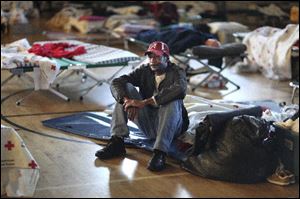
Alabama survivors search for keepsakes
Relief teams offer housing, food aid
5/1/2011
Edward Pyles is among hundreds of people in Tuscaloosa, Ala., who were displaced by the tornadoes and storms that struck the South.
BIRMINGHAM, Ala. — The scope of devastation left by the second-deadliest tornado blast in U.S. history continued to emerge Saturday as stunned survivors combed the wreckage of homes churned into matchsticks and aid workers and volunteers struggled to get food, water, and generators to thousands displaced across seven Southern states.
Hundreds who spent the night in emergency shelters hastily erected in hardest-hit Tuscaloosa, Ala., scoured the remnants of their homes and businesses for photos and keepsakes, mostly in vain.
Many returned dispiritedly to the shelters, where the first federal relief teams were handing out application forms for temporary housing and reconstruction aid.
According to state emergency services, the death toll across the South was at least 341, exceeded only by a 1925 storm sweep that killed 747.
Some of the displaced people in towns throughout the region couldn’t make it back to their properties to assess their losses because security officials had blocked roads and power lines were downed.
Kendra Coleman, her husband, and three sons, were turned away as they tried to return to their three-bedroom apartment in Pratt City from the downtown Birmingham shelter where they had been staying since Wednesday.
At the shelter, Ms. Coleman said they were not permitted to shower and her boys were beginning to tire out.
“They tell me ‘Momma, I wanna go home,’ and I just want to cry,” she said. “Because I have no idea where home is anymore.”
The American Red Cross has opened 16 shelters across Alabama, taking in about 900 of the newly homeless, said spokesman Chris Osborne.
Eqecat, a disaster risk assessment operation, estimated the region sustained $5 billion in insured losses alone from the tornadoes.
Tuscaloosa Mayor Walt Maddox said 39 people were confirmed dead in the area. Although 454 people were reported as missing to authorities, officials cautioned that many probably have been reunited with family or friends. About 30,000 people remained without power, but dozens of generators were being moved to the area to provide electricity to the shelters and makeshift dwellings cropping up to house those made homeless by the disaster.
About 1,000 National Guard soldiers and a mobile relief operations center were on their way from the Federal Emergency Management Agency, Mr. Maddox said.
The Obama Administration continued its response to the disaster as five Cabinet officials prepared to tour the damage and recovery efforts Sunday in the hardest-hit states of Alabama and Mississippi.
“Our top priority is to support the states and communities affected by this as recovery efforts are under way,” said Craig Fugate, administrator of the Federal Emergency Management Agency, who was in the region.
FEMA said it has deployed incident management teams to Alabama, Georgia, Mississippi, Kentucky, and Tennessee. The agency also has set up a support base in Maxwell, Ala., to help move water and other supplies to the affected areas.
The National Oceanic and Atmospheric Administration has sent survey teams to the region to assess and analyze the damage.
And the Nuclear Regulatory Commission continues to monitor the situation at the Browns Ferry nuclear power facility near Athens, Ala., which lost off-site power Wednesday night because of the storms. The plant’s reactors were safely shut down using backup power.